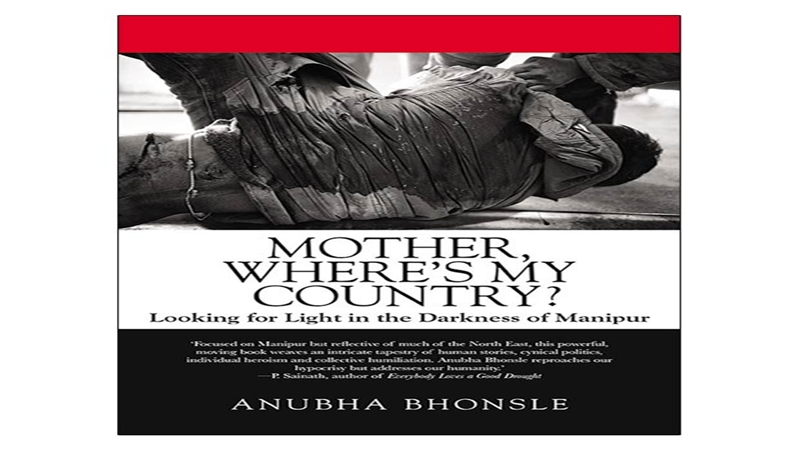“Mother Where’s my Country: Looking for Light in the Darkness of Manipur” by Anubha Bhonsle.
Published: 2016
ISBN No: 978-93-85288-35-7
Pages: 250
Publisher: Speaking Tiger Publishing Pvt. Ltd.
Price: 499
 Manipur; a little paradise on earthwith rich cultural heritage and sublime natural beauty is unfortunately the arena of worse form of political conflicts and human rights violations. Neglected by the Indian democracy that boasts of unity in diversity, Manipur is usually in the headlines for accounts of political turmoil, images of burning down of the state assembly and other state buildings in Imphal, agitations over the killing of Manorama Devi, naked protests by womenfolk, rallies by tribal women and Sharmila Irom. As usually is the case, women are the worse sufferers in times of political conflict. The book takes us through real life accounts of violence inflicted on women by the draconian laws AFSPA and the militant activism of liberation fronts and resistant groups.
Manipur; a little paradise on earthwith rich cultural heritage and sublime natural beauty is unfortunately the arena of worse form of political conflicts and human rights violations. Neglected by the Indian democracy that boasts of unity in diversity, Manipur is usually in the headlines for accounts of political turmoil, images of burning down of the state assembly and other state buildings in Imphal, agitations over the killing of Manorama Devi, naked protests by womenfolk, rallies by tribal women and Sharmila Irom. As usually is the case, women are the worse sufferers in times of political conflict. The book takes us through real life accounts of violence inflicted on women by the draconian laws AFSPA and the militant activism of liberation fronts and resistant groups.
Through a compilation of real life stories presented in an engaging narrative style, the book takes us through the pain, loss and struggles of the women affected by violence. The book weaves together horrific accounts of rape, racism, random killings, stories of the Malon murders, Sharmila Irom’s journey, naked protests by women, the Naga rebels; these disturbing stories urge re examine the values of political democracy from a humanitarian perspective. The disturbing stories of people most affected expose the suffering, resentment and state apathy that has caused victimization of Manipuris. The book contains a well documented account of the violent history of Manipur and continuing battle of the insurgents and Indian soldiers. Describing everything to be in a state of “…tragic flux…” the book philosophically brings out the violent nature of nation states and border markings. The haunting story of death of the innocent Sinam Chandramani (winner of National Bravery Award in 1988) by the army as he was on his way to tutions was one of the incidents that prompted Sharmila Irom to quietly start her fast inside her own home the next day.The book offers a detailed account of Sharmila’s difficult time in the hospital, how she was smuggled to Delhi and her love story with Desmond Coutinho. It poignantly details the pain of nose feeding and the feeling of being exiled and an object of curiosity “ Here in the vast alien land she felt fragile, crushable, overwhelmed by anxiousness and a sense of danger. Here she was a freak show.” Similarly, the details of the haunting stories of the killing of Manorama Devi, the naked protests of women, the Upendra Singh Commission’s travails, and the eventual surrendering of the Kangla Fort by Assam Rifles appear as a freak show. The random violence and lawlessness that rules Manipur is true of most of North East. Infact insurgency very bitterly is described as “the best industry with highest rate of return” as war continues and misery is exploited and encashed.
The book offers no “light”in the times of darkness, though it raises several concerns and adreeses several debates over the powers of the state and security forces, it does not seem to offer any hope. In August 2016, when Sharmila Iron broke her fast, she explained that she did not want to be a mere symbol of resistance, she would take part in politics so that she could bring about positive changes. Her decision evoked mixed responses, but it exposed the frustration that may have set in as her struggles and the voice of the poor/vulnerable remains largely unheard and neglected by not only in national governance but also in media.
North east is barely considered a part of India, most of its citizens are victims of racism as they are identified as “chinkis” and there is little knowledge of its geography, history and plural culture. With such little knowledge of the lands (it may be difficult to remember all the north east states with their capitals!) there is much misunderstanding and little empathy for this distant part of the country. Sunjoy Hazarika, Research Professor at Centre for Policy Research, New Delhi explains the complexities as Northeast appears as a magnificent and tragic tapestry of people, events and nature. It is a land with over three hundred communities in eight states with a population of about thirty five million people, communities with kin in neighboring countries. Sharing borders with not less than four countries 98 per cent of its land borders are with Myanmar, China, Bhutan and Bangladesh. A bare two per cent is India’s share. It is thus not surprising that people and communities there feel alienated and very distant, not just from Delhi, but the rest of the country. The tortures of AFSPA and poor policies of resource allocations are an addition to their alienation that poses a serious challenge to peace and India’s claim of being the largest democracy of the world. The book effectively brings out these issues through the lens of gender and the narratives shock and haunt the reader for long.
Source: Free Press Journal

